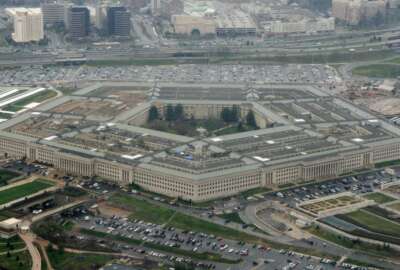Hubbard Radio Washington DC, LLC. All rights reserved. This website is not intended for users located within the European Economic Area.
How to keep new policy from making procurement less efficient
Frontline contracting officers contend with a lot of policy. One thing about policy, it's always changing. And that can get in the way of basic efficiency and p...
Frontline contracting officers contend with a lot of policy. One thing about policy, it’s always changing. And that can get in the way of basic efficiency and pricing considerations. At last week’s National Contract Management Association (NCMA) World Congress in Nashville, Federal Drive with Tom Temin discussed the topic with John Tenaglia, the principal director of pricing and contracting at the Defense Department, and Janice Muskopf, the director of price, cost and finance.
Interview Transcript:
Tom Temin: Here’s an excerpt and understand it was a loud exhibit Hall . And what goes into pricing expertise and knowledge of what prices ought to be? Janice?
Janice Muskopf: Okay. Well, that is a tough subject because like you said, you would think it would be easy, but it’s not necessarily. So one of the things that I do is I’m very involved in training. And as a professional with 34 years in this business, there’s a lot that you learn over time. And so one of the things that I focus on is partnering with organizations like Defense Acquisition University. To teach folks out in contracting and pricing the really tough stuff in our business. So whereas you think it might be simple in a competitive world, I would say pricing can be much more simple. But then we also have our sole source contracts where it becomes more and more challenging.
Tom Temin: Yeah. So I guess the main challenge then is knowing what the cost elements are that go into something that you’re buying, whether it’s manufactured or it’s a service or a software development. And then. Knowing what industry norm is. Or a profit. Is that kind of how we arrive at prices rather than working price on down?
Janice Muskopf: So it’s going to depend on the circumstances. If you have competition that drives price reasonableness. Now we have laws that help us. One of them is called a truthful cost or pricing data and formerly known as the Truth in Negotiations Act. And there’s exceptions to when companies have to provide what we call certified customer pricing data. When they do so, say it’s a major weapons platform. It’s not competed. We are now in with one vendor. We’re locked. And so then you start getting into what are the cost elements. The company is required to provide data to put the contracting officer on equal footing. And we even have tools to aid contracting officers in terms of things like what would a reasonable profit objective be for purpose of the negotiation? And then, of course, there’s a lot of analysis that goes into looking at the data in order to figure out from a government contracting perspective, what do we think are fair and reasonable prices?
Tom Temin: Yes, because I guess a contractor could be totally honest but wrong, which is a different situation than if they’re deliberately making up cost elements. But inflation changes in raw material markets, sudden changes in labor markets locally can all affect what goes into a price, fair to say.
John Tenaglia: So I would talk about the difference between the facts that we ask Companies provide transparency of information is pretty key. A lot of the substantiation of prices that are proposed involve facts, some involve judgment. And so we have techniques to deal with either and ultimately it comes down to negotiation.
Tom Temin: Now your session here at NCMA. I’ll read a sentence from it. How can you balance the need for efficiency while navigating through existing and emerging policies? What were you talking about?
John Tenaglia: So we stand in a position to implement a lot of the policies that the Congress enacts through the National Defense Authorization Act. Those are policy objectives to advance various interests, let’s say cybersecurity, for example. That’s one that comes up quite frequently, recognizing there are positive effects of making sure that the controls that we have over our sensitive information that’s unclassified is sufficient, so it’s protected. But the balance is what of the compliance burden that’s associated with that? Striking the balance in that one particular area. But there’s a lot of other areas of public policy, better socioeconomic objectives, whether it’s in executive orders that the president signs or in the statutes. And so that balancing act comes down to the policies that we implement, either through the rulemaking process, we manage the Federal Acquisition Regulation and the Defense Federal Acquisition Regulation supplement. And so that’s the formal side of our business and implementing and balancing interests. When we get some rulemaking, we see public comment and making sure that we’re understanding what the cost impacts of these compliance are, requirements are.
Tom Temin: My guests are John Tenaglia. He’s principal director for defense pricing and contracting at the Defense Department. And Janice Muskopf the director of pricing, cost and finance. And so the implication then is that new rules and regulations have a compliance cost. They might even have a physical cost in terms of people or labor. And so you have to understand that. So you have to read all those things under 800 zero, through 899, sometimes even more than that to understand the impact on contractors. Fair to say.
Janice Muskopf: I think that there can absolutely be a cost to compliance. And, you know, there’s different sources for the policies that come about. Sometimes they’re, you know, congressionally mandated. Right. And so we go through the public rulemaking process. We look at, you know, impacts. But at the end of the day, you know, if if it’s a law that stems from our Congress, you know, we’re going to put that into the D-FARS.
Tom Temin: Sure. Understood. All right. So give us some examples of a policy that could be reflected in price finance costing all of these issues.
John Tenaglia: Let me talk about just the week before last we issued guidance on the use of other transaction authority. That’s a non-FAR-based authority.
Tom Temin: Yep.
John Tenaglia: And so this is an opportunity to somewhat normalize how other transaction agreements are executed across the department. But the balancing act we’re taking there is not wanting to impose a FAR-like regulatory regime on the use of the transaction authority.
Tom Temin: Yeah, you would kill the goose.
John Tenaglia: Right. Exactly. So but we also want to demonstrate to the Congress that we’re responsibly using that authority in most cases for prototypes, potentially for follow-on production. But there are some aspects to transparency of those transactions that we want to make sure that’s captured. So we’re not going to have a standard slate of terms and conditions for OT agreements like we have in FAR and D-FAR. But we do want to have some reporting and understanding of where those dollars are going. And also, we’re recognizing the consortium style with its most recent issuance. You know, many of the components across the department are using consortium style of the transaction authority, providing some guidance about how that’s done in an optimal way.
Tom Temin: Yeah. On some of the energetics, there’s a big consortium around that for the Defense Department is a couple of these different consortia going and they kind of are a abstraction, layer and sourcing, right, for the D.O.D. So you’ve got to know what’s happening under that layer.
John Tenaglia: Yeah. So that’s one great example. And so we want to make sure that people are aware of that because there’s a tendency to recreate some of these things. The department is a very large institution and we want to make sure that through communities of practice, people understand where they can access existing consortia.
Tom Temin: So what are some of the factors that could cause a financial or pricing effect from a need for compliance? Is it all Labor? Is it all just activity by the contractor that involves people? Janice?
Janice Muskopf: So it’s interesting because as part of our defense contract finance study that came out at the end of April. There is a segment that actually starts looking at things like accounting systems and cost accounting standards and can you determine the cost of compliance. And it’s a very challenging area in terms of actually defining there’s X, you know, amount of dollars. And what the data showed that we saw is that you’re not going to see a consistent answer. It always costs X amount. And, you know, some companies are already subject to things like Gap. And then we get into more specific areas, depending on what kind of contract type that they’re taking on to say it’s cost reimbursement. And one of the things that came out of the finance study that was really interesting to me is when you look at who is actually subject to things like cost accounting standards, which are, I would say, the most strict when we start thinking about these things, it is actually a very, very small percentage of our defense industrial base.
Copyright © 2024 Federal News Network. All rights reserved. This website is not intended for users located within the European Economic Area.
Tom Temin
Tom Temin is host of the Federal Drive and has been providing insight on federal technology and management issues for more than 30 years.
Follow @tteminWFED





